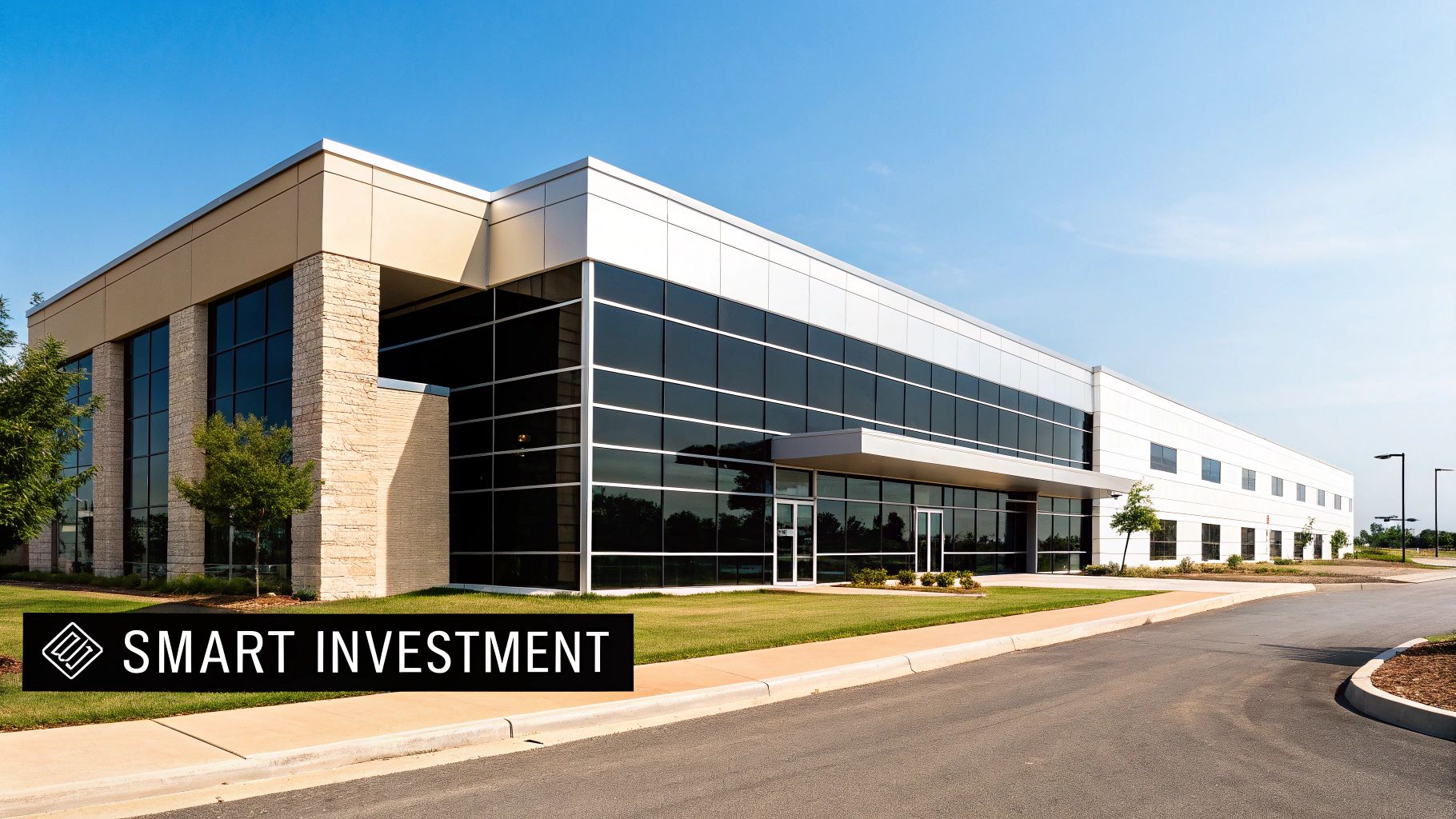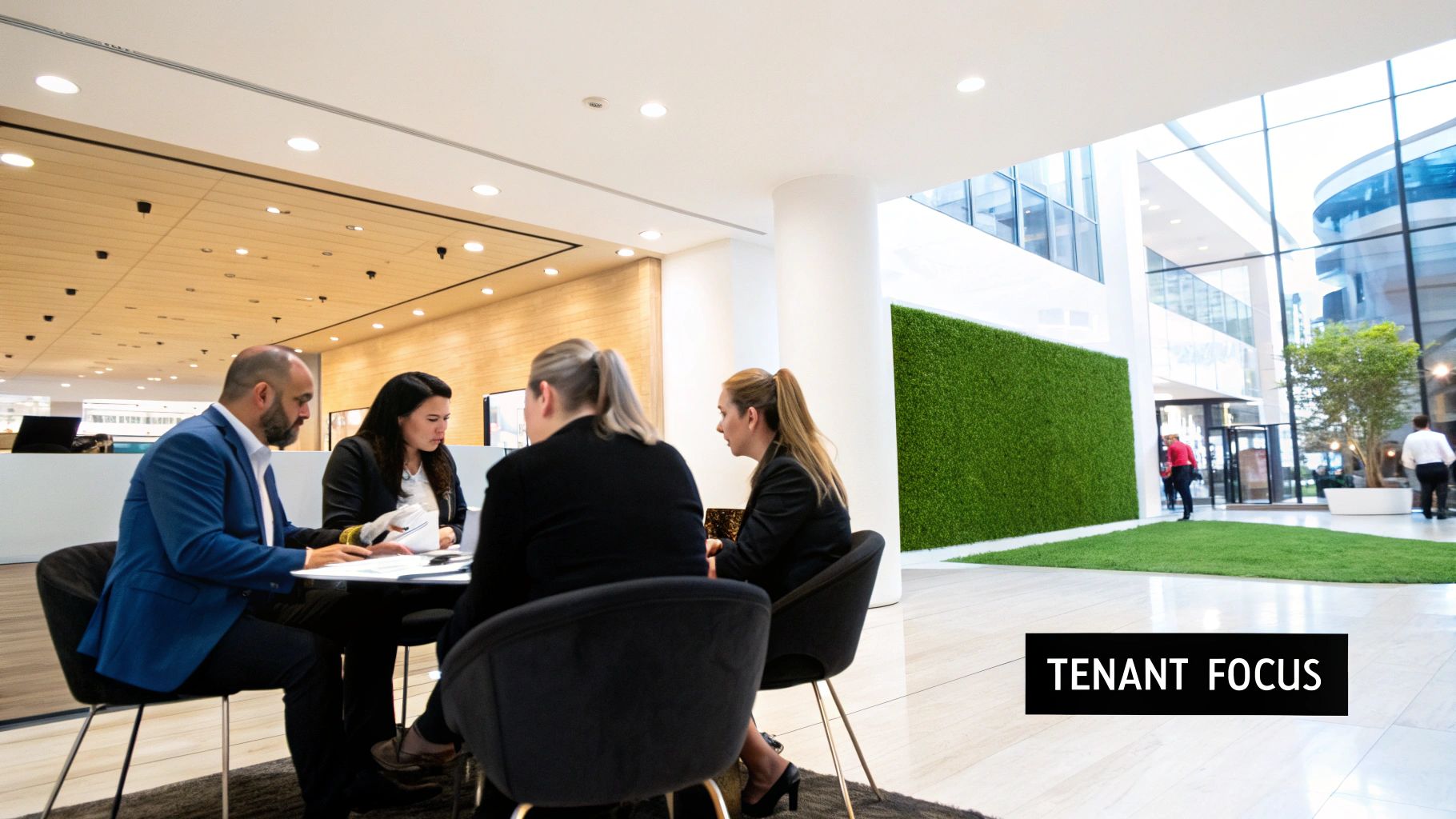
Essential Guide to managing commercial property
Discover expert tactics for managing commercial property that boost profits and ensure sustainable growth. Learn more today!


Discover expert tactics for managing commercial property that boost profits and ensure sustainable growth. Learn more today!


The Australian commercial property market offers a blend of potential rewards and inherent risks. Recent years have witnessed significant shifts, influenced by economic changes and evolving tenant needs. This dynamic market requires a strategic and adaptable approach to commercial property management. Understanding this landscape is key to success.
Let's look at the Australian commercial property management market. It has seen some significant ups and downs. In 2023, the market contracted to AUD 1.9 billion, representing a 22.6% decline. However, 2024 saw a positive turnaround, with the market growing by 10.7% to reach AUD 2.1 billion. This suggests an upward trend, likely fueled by improving economic conditions and increased demand.
Despite these fluctuations, the overall compound annual growth rate (CAGR) from 2019 to 2024 was a modest 0.7%. This reflects the challenges faced during this period. You can find more detailed statistics at IBISWorld. This data reinforces the importance of staying up-to-date with market trends.
To illustrate these trends and statistics further, let's examine the following table:
Commercial Property Management Market OverviewThis table presents key statistics and trends in the commercial property management market over recent years.
The table above clearly shows the volatile nature of the commercial property management market. While there have been periods of growth, the significant contraction in 2023 highlights the need for careful market analysis and strategic planning. The subsequent rebound in 2024 provides a degree of optimism, but the overall modest CAGR emphasizes the importance of prudent decision-making.
Different commercial property sectors, like office, retail, and industrial, are experiencing varying performance levels. The office sector, for example, is adapting to evolving work habits, particularly the rise of hybrid models. This requires a focus on creating flexible and desirable workspaces to attract and retain tenants.
Retail properties face the ongoing challenge of e-commerce and shifting consumer preferences. Innovative strategies are crucial to attract foot traffic and create engaging shopping experiences. The industrial sector, on the other hand, is generally showing strong performance, driven by growth in e-commerce and logistics. Recognizing these sector-specific trends is crucial for effective property management.
Certain market indicators are particularly relevant for successful commercial property management. Vacancy rates, for example, offer valuable insights into market demand and inform pricing decisions. Rental growth forecasts help assess the potential return on investment.
Net absorption rates provide a measure of the overall market health, indicating the balance between supply and demand. Successful property managers actively track these indicators and adapt their strategies as needed. This data-driven approach is essential for making informed choices and maximizing property value.
While the commercial property market presents obstacles, successful property managers leverage these challenges for strategic gain. For example, the shift towards flexible working in the office sector can be met by offering adaptable lease terms and creating co-working environments.
In the retail sector, the growth of e-commerce can be addressed by emphasizing experiential retail and creating unique destinations that attract customers. By acknowledging the specific hurdles within each property type and adopting innovative solutions, property managers can not only navigate the current environment, but also excel within it. This proactive approach is essential for sustained success in the dynamic world of commercial property management.

Successfully managing commercial properties requires a deep understanding of more than just market fluctuations. It takes a particular skill set to handle the intricacies of tenant relationships, finances, and property upkeep. This is especially important in Australia's diverse commercial real estate market, which includes office, retail, and industrial properties.
Managing these properties involves various tasks, from financial oversight to tenant relations and regular maintenance. The Australian commercial real estate market was valued at approximately USD 34.07 billion in 2024. It's projected to grow significantly in the coming years. Explore this topic further here. This dynamic environment demands a diverse skill set for sustained success.
Sound financial skills are crucial for property management. This includes budgeting, forecasting, and conducting thorough financial analysis. Property managers must be adept at analyzing financial statements, understanding market dynamics, and making informed investment decisions.
For instance, a skilled manager can identify opportunities to reduce operational expenses or boost rental income, directly impacting profitability. Understanding key financial metrics like net operating income (NOI) and capitalization rate is essential for evaluating property performance and maximizing returns.
Beyond financial expertise, building and nurturing positive tenant relationships is paramount. This involves clear and consistent communication, prompt responses to inquiries, and a genuine understanding of tenant requirements.
A property manager who proactively addresses tenant concerns and fosters open communication can considerably improve tenant satisfaction and retention. This, in turn, minimizes vacancy rates and contributes to long-term property value appreciation.
Effective negotiation is a cornerstone of securing lease agreements that benefit both property owners and tenants. This involves a deep understanding of market conditions, lease terms, and the specific needs of each party.
A skilled negotiator can achieve mutually beneficial outcomes, ensuring fair agreements while maximizing rental income. This skill also comes into play when negotiating with vendors, ensuring competitive pricing for property services and maintenance.
Commercial property management inevitably involves navigating unforeseen events, ranging from urgent maintenance needs to tenant disputes. Effective crisis management demands quick thinking, strong problem-solving abilities, and the ability to remain composed under pressure.
This involves developing comprehensive contingency plans, establishing clear communication protocols, and being prepared to tackle unexpected challenges efficiently and effectively.
Successful property managers recognize the importance of assembling and leading a high-performing team. This includes recruiting qualified professionals, providing ongoing training and development opportunities, and fostering a positive and productive work environment.
A motivated and well-trained team can efficiently handle daily operations, tenant interactions, and property maintenance, all of which contribute to the property's overall success.

Smart property managers know that access to market data isn't the challenge; the real skill lies in turning that data into actionable strategies. This means not just understanding current trends, but also anticipating future shifts to position properties for optimal performance. This forward-thinking approach allows managers to seize emerging opportunities before the competition. Proactive planning is a major factor in achieving exceptional results.
The Australian commercial real estate market offers a compelling example. In 2024, the market was valued at USD 34.07 billion, and is projected to expand at a CAGR of 8.46%, reaching USD 51.14 billion by 2029. This growth is driven by strong economic fundamentals and significant investments in infrastructure. You can explore more detailed statistics here. This positive trajectory offers substantial opportunities for insightful property managers.
It's crucial to understand that not all market trends are equally important. The ability to identify which trends will significantly impact particular property types and locations is essential. For instance, the rise of e-commerce might negatively affect traditional retail spaces, while benefiting industrial warehouses and logistics hubs. This highlights the need for property managers to deeply understand the forces driving change in their niche.
Local economic conditions, population changes, and infrastructure development can all heavily influence property values. Effective property managers carefully monitor these local indicators to evaluate their potential effects and adapt strategies accordingly. This localized market analysis is vital for making well-informed decisions.
Putting market analysis into practice requires a structured approach. This involves a few key steps:
Using this systematic method ensures that actions are guided by a clear strategic vision. This framework provides a stable base for making rational and objective choices, even when market conditions are uncertain.
Let's take a look at how different commercial property sectors stack up against each other based on these key metrics:
Commercial Property Sector Comparison
This table compares different commercial property sectors by key investment metrics and management considerations.
This table illustrates the diverse investment profiles of various commercial property sectors. Industrial properties currently offer the highest potential ROI and strong growth potential, while retail properties demand more complex management and face more variable growth prospects.
Economic indicators offer valuable insights when correctly interpreted. Property managers can leverage these indicators to take practical actions that improve performance. For example, increasing interest rates might signal a need to adjust rental pricing or consider refinancing existing loans. Likewise, rising vacancy rates might suggest enhancing property amenities or revising marketing efforts to attract tenants. Reacting effectively to market signals is a key characteristic of successful property management.
Understanding tenant needs and preferences is equally crucial. This can involve providing flexible lease terms, integrating sustainable building features, or offering modern amenities. By proactively meeting tenant demands, property managers can create more desirable and competitive properties. This tenant-focused approach builds stronger tenant relationships and contributes to increased property value and tenant retention.

Retail and hospitality properties come with their own unique set of complexities within the commercial property world. These sectors require specific expertise and strategies to meet their distinct operational needs. It's all about understanding how to create dynamic destinations that attract customers and help tenants thrive.
Successfully managing retail and hospitality properties relies heavily on selecting the right combination of tenants. This goes beyond simply filling empty spaces. It involves crafting a synergistic atmosphere where businesses complement each other, collectively attracting a larger customer base.
Imagine a bustling coffee shop situated next to a cozy bookstore. They attract similar customer demographics, creating a natural flow of foot traffic between them. A diverse tenant mix boosts individual business performance while enhancing the property's overall appeal.
This strategic approach to tenant selection fosters a sense of community and elevates the overall experience, making the property a more desirable destination. This interconnectedness becomes a key differentiator in today's competitive market.
Attractive amenities are essential for attracting and retaining both tenants and customers in these sectors. However, effective property management requires carefully balancing these desirable features with the practicalities of operating costs.
This involves strategic decisions about which amenities offer the most value while minimizing unnecessary expenses. Free Wi-Fi, for example, might be a cost-effective way to improve customer experience, while a large, elaborate outdoor area might require significant upkeep. Striking the right balance between attracting customers and controlling expenses is crucial for long-term profitability. This delicate balancing act remains a constant challenge for property managers.
Understanding market trends and consumer behavior is essential in commercial property management. For instance, Australia's retail sector thrives thanks to a strong consumer culture, with total retail spending reaching USD 242 billion in 2022. Find more detailed statistics here. This high demand makes retail spaces attractive to investors seeking stable income through long-term leases. Furthermore, the hospitality sector is also experiencing growth, fueled by tourism, presenting various investment opportunities in hotels, restaurants, and resorts. These trends highlight the importance of adapting property management strategies to meet evolving market dynamics.
Consumer preferences and behaviors are constantly in flux, especially in the fast-paced retail and hospitality sectors. Successful property managers understand the need to adapt their strategies to keep up with these changes.
This might involve incorporating flexible space designs to accommodate changing tenant needs, integrating technology to enhance customer experience, or adopting sustainable practices that appeal to environmentally conscious consumers. Pop-up spaces within a retail center, for example, offer short-term leasing opportunities for emerging brands, attracting new customers and creating excitement. This flexibility caters to evolving retail trends and helps property managers stay ahead of the curve.
Finally, cultivating strong relationships with tenants is crucial in retail and hospitality property management. Creating a supportive environment where tenants feel valued and understood can lead to higher retention rates and improved overall property performance.
This involves open communication, proactive problem-solving, and a genuine interest in tenant success. A property manager could, for instance, facilitate networking opportunities among tenants, fostering a sense of community and collaboration. This benefits individual businesses and creates a more vibrant and attractive destination for customers. This collaborative approach establishes a strong foundation for long-term success.
Technology is changing the way we manage commercial real estate, offering tools to improve efficiency and tenant satisfaction. With so many options, it's important to choose solutions that deliver real results. This means looking beyond the marketing and identifying the technologies that truly add value. Let's explore some key examples.
Property Management Systems (PMS) are essential for today's property managers. These platforms bring together core functions like rent collection, lease tracking, and maintenance requests. This simplifies administrative work, reduces paperwork, and offers a clear picture of property performance.
Automated Rent Collection: Reduces late payments and simplifies accounting.
Centralized Lease Management: Provides easy access to lease terms and expiration dates.
Streamlined Maintenance: Tracks requests, schedules repairs, and manages vendor communication.
A good PMS acts as a central hub, connecting all aspects of property management and delivering valuable data for informed decision-making. This integrated approach improves efficiency and allows for smarter resource allocation.
The Internet of Things (IoT) offers exciting potential for commercial real estate. IoT devices, such as smart sensors and meters, gather real-time data on energy use, occupancy, and environmental conditions. This data offers valuable insights that can be used to optimize building performance and improve tenant comfort. For instance, smart thermostats can automatically adjust temperature based on occupancy, significantly lowering energy costs.
Real-Time Data Collection: Provides constant feedback on building systems.
Predictive Maintenance: Identifies potential problems before they become expensive repairs.
Enhanced Tenant Experience: Provides personalized comfort and convenience.
By incorporating IoT devices, property managers gain a deeper understanding of how their buildings are used, enabling better management practices.
Data is only valuable if you can interpret and use it. Data analytics tools empower property managers to analyze the large amounts of data gathered by PMS and IoT devices. This analysis can reveal trends, highlight areas for improvement, and guide strategic decisions.
Performance Benchmarking: Compares property performance to market averages.
Predictive Modeling: Projects future trends and identifies potential challenges.
Data-Driven Decision Making: Supports strategic choices with factual insights.
For example, studying tenant feedback can reveal specific areas where tenant satisfaction can be boosted. This data-driven approach helps refine management strategies and ensures that actions align with tenant needs and market trends.
While technology offers significant potential, property managers must carefully consider the return on investment (ROI). This involves assessing the initial setup costs and the ongoing costs of maintenance and support. It also requires examining the potential benefits, such as improved efficiency, lower expenses, and greater tenant satisfaction. By carefully evaluating the costs and benefits, property managers can make sound decisions about which technologies are worthwhile investments. This strategic approach helps avoid expensive errors and ensures that technology investments genuinely improve a property's financial performance.
By strategically adopting these technologies, property managers can improve operational efficiency, boost tenant satisfaction, and build a lasting competitive edge.
Smart financial strategies are key to maximizing the value of commercial properties. The difference between average and exceptional property performance often comes down to these strategies. Let's explore how strategic property managers optimize their financial approaches to generate superior returns. These approaches center around maximizing income, controlling expenses, and making smart investments.
Lease structures are essential to a property's financial health. Strategic managers focus on creating lease agreements that work for both owners and tenants.
Negotiating Favorable Terms: Securing the best lease terms is crucial for long-term financial stability. This involves understanding market rental rates, lease durations, and options for rent escalations.
Balancing Short-Term and Long-Term Revenue: Maximizing immediate rental income is important, but so is considering the long-term impact of lease agreements. Flexible lease terms can attract and retain tenants, leading to stable occupancy.
Understanding Tenant Needs: Understanding tenant needs allows property managers to create leases with mutually beneficial terms, building positive relationships and boosting tenant retention.
Strategic property improvements can significantly increase a property's value and attract higher-paying tenants. Prioritizing improvements with a clear return on investment (ROI) is essential.
Identifying Profitable Upgrades: Before investing in improvements, conduct thorough research and analysis. Determine which upgrades will generate the greatest returns. Renovating common areas or upgrading building systems, for example, can make the property more desirable and justify higher rents.
Timing Renovations for Maximum Impact: The timing of renovations matters. Coordinating upgrades with lease renewals or market upturns can maximize returns and minimize disruptions.
Tracking and Measuring ROI: Monitor and measure the financial performance of value-add improvements to ensure they are delivering the expected returns. This helps refine investment strategies and ensures capital expenditures are aligned with financial objectives.
Controlling operating costs is crucial for profitability. Effective expense management requires a systematic approach.
Regular Cost Analysis: Regularly review expenses to find potential savings. This could involve negotiating better contracts with vendors or implementing energy-efficient technologies.
Preventive Maintenance: Investing in regular property maintenance can prevent costly emergency repairs. This includes regular inspections of building systems and promptly addressing minor issues.
Budgeting and Forecasting: Develop a detailed budget and regularly forecast expenses to track spending and identify potential cost overruns. This enables timely adjustments and better financial control.
Sophisticated financial tools are critical for effective property management.
Financial Modeling: Creating accurate financial models helps project future performance and evaluate the potential impact of investment decisions. Tools like Microsoft Excel can be instrumental in this process.
Performance Benchmarking: Comparing property performance to industry benchmarks helps managers assess their effectiveness and identify areas for improvement. Resources like the Institute of Real Estate Management (IREM) offer valuable benchmarking data.
Strategic Planning: A long-term strategic financial plan is crucial for navigating market changes and ensuring consistent growth. This plan should outline clear financial goals, strategies, and monitoring mechanisms.
By incorporating these financial strategies, commercial property managers can maximize property value, attract and retain quality tenants, and achieve long-term financial success. This proactive, data-driven approach is essential for success in the commercial property market.
Managing commercial property effectively means looking ahead, not just reacting to the present. This proactive strategy, known as future-proofing, builds resilience and adaptability into your portfolio, allowing it to weather market changes. Future-proofing involves understanding emerging trends, developing flexible spaces, and implementing sustainable practices. Let's explore how to put this strategic approach into action.
Staying ahead means spotting trends that will impact different property sectors. For example, the increasing demand for flexible workspaces is reshaping the office sector. This means creating adaptable office environments that can meet changing tenant needs. The rise of e-commerce is another example, influencing both retail and industrial properties and requiring shifts in management strategies. Awareness of these shifts is crucial for making informed decisions.
Creating adaptable spaces that can evolve with tenant requirements is key to future-proofing. This could mean designing modular office layouts that can be easily reconfigured, or offering flexible lease terms that meet changing business needs. In retail, it might mean creating spaces that can accommodate both traditional retail and pop-up shops, or incorporating event areas. This adaptability keeps a property relevant and attractive to a wider range of tenants.
Sustainability is essential. Implementing eco-friendly practices, such as energy-efficient lighting and water conservation measures, increases both the value and marketability of a property. Tenants are increasingly looking for sustainable buildings, recognizing both the environmental and financial benefits. This focus on sustainability sets properties up for long-term success and attracts environmentally conscious tenants.
Future-proofing also involves using specific frameworks for strategic management. These include:
These strategies provide a structured way to anticipate and manage future challenges.
Future-proofing is a continuous process. Regularly assessing the property's performance, checking how effective current strategies are, and making any needed changes are vital. This continuous improvement approach keeps the property competitive and well-positioned for future success.
Managing commercial property well in a changing market requires a proactive and adaptable strategy. Future-proofing your portfolio with these strategies ensures long-term stability and maximizes returns. For expert guidance and support in navigating the complexities of commercial property management, consider partnering with Shayne Mele Buyers Agent. Learn more about maximizing your property's potential.